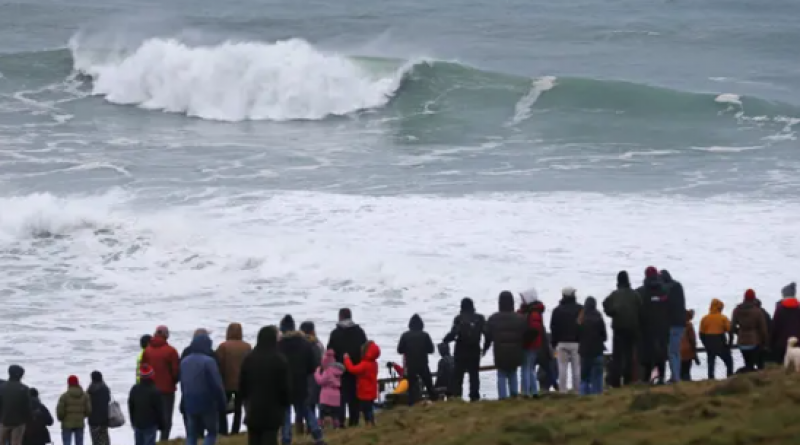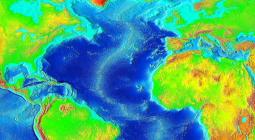Changes in Atlantic currents may have dire climate implications for the next century.

Without modifying human behaviour we run the risk of violent weather swings and a drastic effect on crops and ocean life.
The ocean circulation that keeps our relatively northern corner of Europe warm(ish) is often likened to a gigantic conveyor belt bringing warm equatorial water northwards at the surface, balanced by cold southward flow at great depth. The Atlantic Meridional Overturning Circulation, or AMOC for short, brings heat energy northward at the equivalent rate of 10 Hiroshima bombs every second and keeps our weather mild, and just a little bit too damp, and is critical to the wider climate.
New research has provided important long-term context for scientists’ observations of these Atlantic currents that bring warmth and climatic stability to our shores, with concerning implications for the coming century. Changes in the AMOC in the geologic past have caused significant local and global impacts, and for several decades now oceanographers have been monitoring its strength.
Computer modelling and theory predict a steady reduction in the strength of the AMOC and its heat-delivery service in response to human-induced changes in rainfall, river runoff and the melting of Arctic sea ice and the Greenland ice sheet. Additionally, they show that the AMOC is one of the global climate “tipping points”. If reduced beyond a certain, currently uncertain, limit it may collapse suddenly, with huge implications for our lives. Our best observational estimates, based on oceanographic data back to 1871, show that there has already been an approximate 15% reduction in AMOC strength.
What is missing, though, is longer-term context: is the present decline part of a long natural cycle, or is it due to human influence?
Research published in the journal Nature Geoscience this week has provided this context. Authors from Ireland, Germany and the UK have shown that the AMOC is the weakest it has been at any point in more than 1,000 years. They have done this using a combination of 11 different “proxy measurements” that indirectly infer the AMOC strength. These proxies include marine sediment composition, tree rings, ice-core chemistry and other exotic measurements that make up the bread and butter of the niche-within-a-niche field of paleoceanography.
On their own, any single such record should be interpreted with caution, but nine of these 11 proxies show a reduction in the AMOC strength since the late 1800s, with an even greater weakening since the 1960s. Importantly, they also show that prior to about 1850, the approximate start of human industrial influence, the AMOC strength was relatively steady right back to before 400 AD.
This provides critical observational evidence linking human influence to the decline in the AMOC strength, backing up what climate models have been showing for decades. These same models also predict that under current emission rates the AMOC may be reduced to less than half its original strength by the year 2100. There is still a great deal of uncertainty here, but the message is a robust one: continued greenhouse gas emissions will drive the AMOC lower and lower. Fortunately, the recent Special Report on the Oceans and Cryosphere from the Intergovernmental Panel on Climate Change concluded that we were still “very unlikely” to encounter the tipping point in the present century, but this does not mean there aren’t consequences in the nearer term.
A reduced AMOC is projected to bring colder weather overall to the UK and northern Europe, with much more intense winters and storms off the Atlantic, as well as reduced summer rainfall and crop productivity and a greater likelihood of extreme weather events such as the 2015 European summer heatwave. The impacts are not limited to this side of the Atlantic either. Increased sea levels are predicted on the US eastern seaboard, with the associated increased risks of flooding and potentially increased hurricane intensities.
Such large changes in ocean circulation also put the ecosystems and aquaculture we depend upon at risk. Marine deoxygenation and changes in key species abundances have been linked to an AMOC slowdown, along with an overall reduction in North Atlantic ocean productivity.
The far southern end of the AMOC around Antarctica is also of concern. The global ocean as a whole has absorbed more than 90% of human induced warming, absolutely dwarfing the changes in air temperature that we are all so concerned with. The vast ocean ringing Antarctica is where most of this extra heat (and carbon dioxide) has been injected into the deep ocean, and it is warming and acidifying at an alarming rate. One of the main areas of research for oceanographers such as myself is whether the ocean will continue to essentially sweep human impacts under the carpet – and what may happen if that stops.
This should not be a cause for despair and inaction though. The same models that predict the AMOC slowdown also show that strong emission reductions now can drive an AMOC recovery towards the end of the century. Research may reduce uncertainties, but the message is clear: strong climate action at governmental and industrial levels is needed now, and it is the job of the people to force such action with their wallets and votes.
-
Andrew Meijers is a physical oceanographer at the British Antarctic Survey. He is deputy science leader of the Polar Oceans team and leads the Orchestra research programme studying ocean circulation and its impact on climate
26 February 2021
The Guardian



